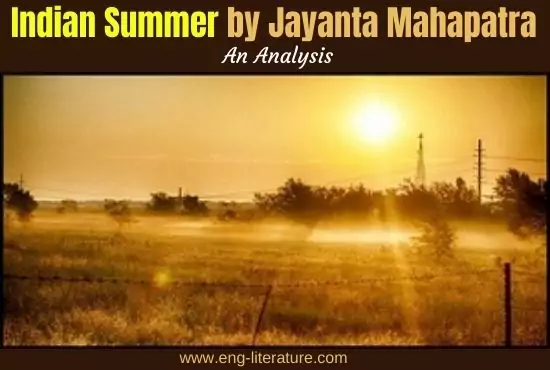
Indian Summer by Jayanta Mahapatra Analysis
All the three poems namely Indian Summer, A Missing Person; and Dawn at Puri belong to the kind of poetry which came into prominence in the early years of the twentieth century. This poetry came to be known as Imagist poetry. It was an American poet by the name of Ezra Pound (1885 1972) who, in collaboration with a few English poets, founded the Imagist movement in poetry. This kind of poetry involved and, in fact, required the use of free rhythms, concreteness, and a conciseness of language and imagery.
An Imagist poem tends to be short; it consists of short lines of musical cadence; it does not necessarily observe any metrical regularity: it avoids abstractions, and treats an image with a hard, clear precision rather than with any symbolic intent. The poetess Amy Lowell succeeded Pound as a spokesperson of the Imagist group, and edited several Imagist anthologies.
Indian Summer is a very short poem which contains a number of vivid and concrete pictures and does not express any idea in specific terms to enable us to judge the theme of the poem. The theme can he judged only by the title of the poem, and we are expected to visualize what an Indian summer is on the basis of the images which have been presented by Jayanta Mahapatra.
There is a sombre wind blowing. The temple priests are chanting their sacred verses in louder voices than the ones which they usually produce. Crocodiles have moved into deeper waters. Heaps of rubbish, which were set alight, may be seen smoldering in the morning sunlight. These are all disconnected pictures, with none of them being in any way inter-related to the others. We are only to imagine that these pictures convey to us some of the prominent features of an Indian summer or to acquaint us with the spirit of an Indian Summer.
But something more is to come. A rather intimate picture is given to us in the last five lines of the poem. It is a picture of the speaker’s “good wife” who continues to lie in his bed throughout the long afternoon, dreaming still, and unexhausted by the deep and loud sounds coming from the funeral pyres nearby.
Also Read:
What does all this amount to ? Rationally speaking, it amounts to nothing. But poetically speaking we are here confronted with the very spirit of an Indian summer, especially a summer in Orissa. The most interesting parts of this poem come in the beginning and at the end. The priests chanting in louder voices than before certainly constitute a realistic audio-visual picture, and it is also something amusing.
But even more interesting is the remark that the mouths of the priests uttering the sacred verses represent the mouth of India opening. Thus the country is here identified with the chanting priests. The priests, hypocritical of course, are regarded here as a symbol of the whole country the majority of whose inhabitants are Hindus. Mahapatra is here mocking at the priests.
The closing lines are interesting in view of the picture they contain of the “good wife” lying throughout the afternoon in her husband’s bed. The word “good” has here been used ironically. In what sense is she good? Is she good because she lies in a relaxed mood and is dreaming throughout the long afternoon? Or, is she good because she is doing no harm to anybody? And is she lying in her husband’s bed because in India the man’s bed is always more comfortable than a wife’s is? Finally, there is reference to the funeral pyres which impart a touch of gloom to the whole poem. Funeral pyres symbolize death; and death is one of Mahapatra’s favourite themes.
The poem undoubtedly fulfils all the requirements of Imagist poetry. The rhythm is free; the images are concrete, almost tangible; the style is characterized by conciseness and precision. However, symbolism is not absent. The priests and the funeral pyres have obvious symbolic significance.

Hello, Viewers! Besides being the Founder and Owner of this website, I am a Government Officer. As a hardcore literary lover, I am pursuing my dream by writing notes and articles related to Literature. Drop me a line anytime, whether it’s about any queries or demands or just to share your well-being. I’d love to hear from you. Thanks for stopping by!
you are an eminent personality. I appreciate your hardworking . thank you SIR
Not as much…I am pretty down to earth… Sincerely welcome….
Thanks so for notes